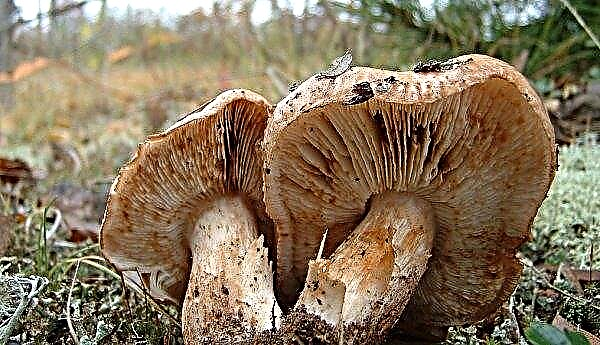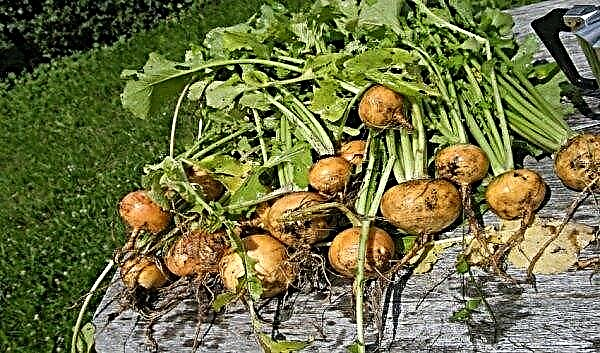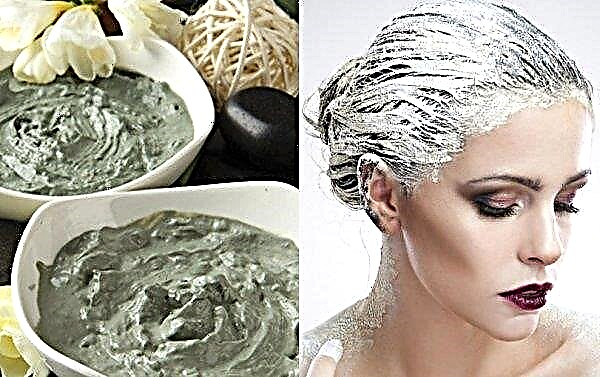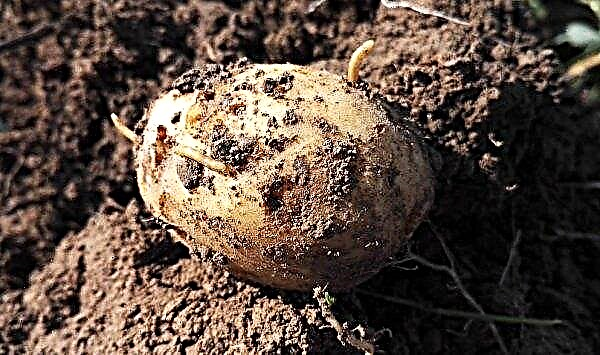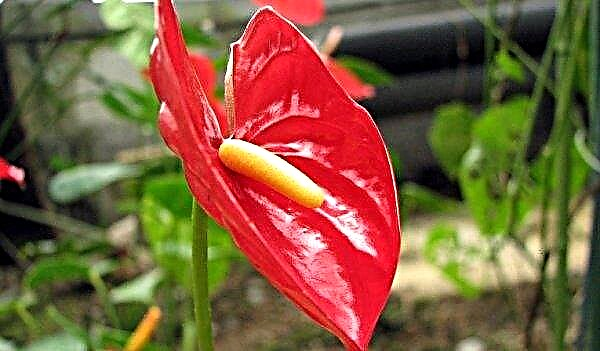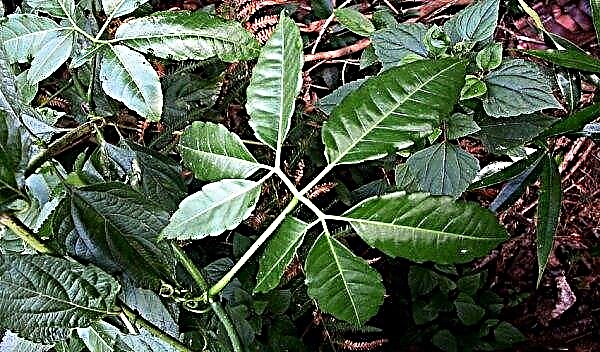Chlorophytum crested is one of our flower growers' favorite flowers. Many appreciate him for his unpretentiousness, resistance to various diseases and pests, others like the decorative look, for which he is often called the spider or lily of St. Bernard. From this article you will learn how to care for him and how to provide a lush and attractive crown for a long time.
Botanical description of the plant
Not so long ago, crested chlorophytum was a representative of the Lilein family. However, the London Royal Botanic Gardens, located in Kew, revised the classification, and the plant was included in the Asparagus family. According to the GRIN site, crested chlorophytum belongs to the Agave subfamily.
The homeland of this flower can be considered the tropical and subtropical zones of the southern part of the African continent, the Australian continent and Asia. It belongs to herbaceous plants and grows, like other epiphytic plants, on tree trunks, attaching its roots to the bark.This flower attracts gardeners with its appearance. Narrow oblong leaves are collected in bunches, grow from the root area and rise above the ground. The height of crested chlorophytum in the natural environment varies from 15 to 25 cm, but at home it can reach 40 cm.
Narrow (up to 3 cm), but long (up to 50 cm) leaves go down and form a beautiful and magnificent cap. Crested, unlike other varieties of chlorophytum, has a white-green leaf. This shape of the crown and the colors of the leaves look especially attractive in a hanging planter.
Did you know? Naturalists from Europe brought it about 2 centuries ago and called it a “green plant”. Growing it as an indoor flower began only in the last decades of the 19th century.
The flowering period most often falls in the spring. Small flowers of a green or white hue of chlorophytum form inflorescences on a thin, flowering stem. After flowering, sprouts with aerial roots, which are nourished by moisture, form on the stem. Such processes or, as they are also called, rosettes are subsequently used for reproduction.
The root system of this flower is developing. It grows quite quickly and fills all the free space in the pot.
Chlorophytum crested (Chlorophytum comosum) has several varieties that differ in color and leaf shape:
Benefit
Many flower growers appreciate crested chlorophytum for its ability to purify air. It is scientifically proven that in the process of its life the plant produces volatile production. These substances absorb harmful microorganisms, bacteria, phenols, mold and formaldehydes, as well as other substances that are produced during the combustion of the gas, when the glue dries, or when smoke occurs.
Did you know? According to scientific studies, crested chlorophytum is able to remove up to 80% of harmful substances from the environment. The most effective cleansing occurs within a radius of 2 m from the flower.
Growing conditions
Crested chlorophytum is unpretentious, but it needs certain conditions to maintain an attractive decorative look.
Seat selection
This flower is a photophilous plant, which allows you to save the colorful colors of the crown. Species such as crested are best grown on the eastern or western side, where the flower will receive the right amount of light. In cloudy weather and in winter, when there is not enough light, the flower can be placed on the south window.

Lack of lighting leads to a loss of motley greens and a slowdown in growth. For good growth, the flower needs a daylight hours of 14 - 18 hours.
Important! Direct sunlight can cause burns on the leaf plate, especially if the spider is on the window on the south side at noon.
Temperature mode
The most favorable temperature for growing crested chlorophytum is + 12 ... + 25 ºС, however, in winter, lowering the temperature below + 10ºС will be harmful.
In summer, one should not allow a temperature increase of more than +25 ºС, since the flower does not tolerate heat. If the apartment is hot enough (more than + 25 ºС), chlorophytum should be sprayed regularly.
Air humidity
The green plant survives well in both dry and humid climates. Periodic spraying favorably affects the growth of chlorophytum. It can also be bathed periodically in a warm shower, thus removing the layer of dust that collects on the leaves.
If the air in the room is too dry or the heater is very close, then the tips of the leaves begin to dry out. Therefore, do not forget about additional hydration.
How to care at home
Although chlorophytum is classified as a picky plant, it still needs constant care: top dressing, watering, pruning and transplanting.
Watering
The spider needs regular watering. However, if you forget to water the plant on time, then it will also tolerate a moisture deficit. The first signs of a lack of moisture will be leaves that will dry out.
Abundant watering to chlorophytum crested is required during the growing season. Then its soil is moistened twice a week, while making sure that the water does not stagnate in the pot and waterlogging the soil. In the dormant period (autumn - early spring), watering can be reduced to once every 7 days or according to the need of the flower for moisture, since the next time you water the soil should be dry.

For irrigation use settled water at room temperature, while using the surface irrigation method. It is necessary to ensure that drops of water do not fall into the outlet of the leaves, as this can lead to decay of the flower.
Top dressing
The flower needs additional recharge only during the period of active growth, when the flower begins to bloom and processes are formed (the so-called "children"), i.e. from May to August. During this period, it is fertilized no more than 2 times a month.
For feeding, use soluble organic-mineral fertilizers for indoor plants (for example, Agricola or Rost-Begonia), which are introduced during irrigation, thereby protecting the root system from burns.
If you want to stimulate the growth of chlorophytum, you should use top dressing from potassium nitrate, urea or ammofoski.
Pruning
This plant does not require special pruning, but it is carried out to form a beautiful bush. Cut off as necessary, while trying not to harm the inside of the outlet. Unnecessary shoots with “children” and yellowed leaves are most often removed. This is best done with scissors.
Transfer
Since the crested chlorophytum root system is quite powerful and grows very quickly, the flower needs regular transplantation. Most often this is done 2–3 times a year, however, it is possible and less often, the main thing is to focus on the root system.
The first transplant must be done in February - March, when the stage of active growth has not yet arrived. In July - August, you need to check the root system and, if necessary, transplant. A transplant during these months will allow the plant to take root and take root well before the onset of winter and a dormant period.
When it penetrates through the drainage holes, it is necessary to transplant the flower into a new pot. In this case, use a larger plastic pot, which should be at least 2 cm larger in diameter of the previous one. During the transplant, the root system is preliminarily cleaned of soil, after which they are disinfected in a weak solution of potassium permanganate.
As a substrate, a soil mixture is used that does not contain peat, and the pH value is more than 7 units. A light and nutritious mixture is best. You can use a mixture of equal parts of deciduous land, humus and coarse sand.Did you know? Crested chlorophytum has hypoallergenic properties, so they are recommended to be placed in hospitals, clinics and child care facilities.
The new soil must first be calcined in the oven, and then cooled to room temperature. The roots are carefully straightened, trying not to damage. The distance from the root system to the bottom of the pot should be at least 1 cm, while not forgetting about the drainage layer. After that, the plant is planted in a new pot and covered with a prepared substrate. The soil is well compacted and moistened.
Video: Chlorophytum Transplant
How to breed at home
At home, the flower multiplies with the help of children or dividing the bush.
Kids
Reproduction with the help of children is the simplest and most common. This method is quite gentle, as it does not cause much harm to the mother plant.
The processes can be harvested when pruning an adult plant. However, it is only necessary to produce such a blank when the root system of the children is already well formed and there are several leaves. For better rooting, some flower growers put shoots in water, and plant already when the roots grow more than 2 cm.

Rooted children are planted in a small pot. After planting, a small plant is best placed next to a large one, in which case the plant will take root faster. Rearrangement is possible only after the appearance of new leaves, which will indicate the rooting of the flower.
Dividing the bush
When transplanting, the bush can be divided. Such reproduction is best done in early spring, so that the flowers have time to gain strength. Before dividing, it is necessary to water the adult flower well.
The mother flower is taken out of the pot. Gently free the root system of excess soil. After that, you should carefully look at possible methods of division.
Important! It is necessary to divide the root system so that the new plant has a separate elongated tuber.
You can divide the plant with a knife. After division, the roots of two plants are placed in a light raspberry potassium permanganate solution. This treatment protects the root system from unwanted damage.

When the root system is prepared and dried, the flowers are planted in a new nutrient ground and watered well. After division, crested chlorophytum should not be fertilized for at least several weeks, as this can cause damage and lead to its decay.
Possible growing difficulties
When breeding crested chlorophytum, various difficulties can arise, which include not only diseases and pests, but also yellowing of leaves or dimming of color. The main thing is to identify the problem in time and know the methods of dealing with it.
Although this plant is quite resistant to various diseases, however, gardeners may encounter root rot. It occurs during acidification of the root system as a result of waterlogging of the soil. As a result, the plant affects the fungus, which spreads throughout the plant, and appears on the leaves in the form of spots. At an early stage, you can deal with this problem with the help of a drug such as Fitosporin, which processes the soil and plant. If this does not help, then fungicides should be used. For example, you can use Topaz or any other drug that you can buy at the nearest flower shop.
At an early stage, you can deal with this problem with the help of a drug such as Fitosporin, which processes the soil and plant. If this does not help, then fungicides should be used. For example, you can use Topaz or any other drug that you can buy at the nearest flower shop.
Tufted chlorophytum can be affected by pests such as thrips, spider mites and scale insects. With each of them you need to know how to deal. Thrips are small insects whose appearance resembles dash sticks. However, unlike the latter, they cause irreparable damage. On the leaves, when these pests are affected, light oblong spots appear on which excrement can be distinguished. Thrips, spider mite and scale insects
Thrips, spider mite and scale insects
The scabbard is simply enough to make out, the main thing is to regularly inspect the plant so as not to miss the moment and start the fight against this pest in time. You can deal with these pests using a soap solution or insecticides, for example, Vitaros or Acrobat.
If a spider infects a spider mite, then a thin spider web appears on the leaves, which braids the leaves and stems. Over time, spots appear on the leaves, and they begin to fade. The plant can be treated with hot soapy water, the temperature of which reaches 50ºС.
In more complex cases, when the plant is severely affected, you can use Nisaran or Apoll or other acaricidal drugs. Also, one should not forget about regular spraying, since this pest infects the plant in a dry and hot climate.
In addition to pests and diseases, flower growers may encounter such problems:
Even with severe damage, chlorophytum recovers quite quickly. The main thing is to adjust the conditions of maintenance and care of the plant.Chlorophytum crested, or in common people - a “spider”, refers to unpretentious plants that easily breed. These qualities have made him a real favorite among indoor flowers for many years. With improper care, leaves may turn yellow or a variety of pests or diseases can attack the plant. However, no matter how much the flower is struck, it is characterized by incredible vitality.

